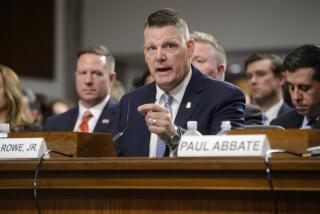Where Bodyguards Spell Status, Some VIPs Prefer a Lower Profile
- Share via
WASHINGTON — It’s a typical scene in the capital: A black sedan with a red light on the dash sweeps into the Supreme Court basement.
Several eagle-eyed FBI guards hover nervously around the side entrance of the imposing, white marble building as Atty. Gen. Dick Thornburgh steps out of the car. Make no mistake, they know their mission is to protect the boss.
But wait--isn’t that Chief Justice William H. Rehnquist dashing up the stairs alone, off for his morning stroll near Capitol Hill?
The contrast between the entourage surrounding the attorney general and the solitary wandering of the nation’s top judicial official illustrates the wide variety of personal security arrangements in and around Washington.
In general, security here has been stepped up in the 1980s, a decade punctuated by terrorist threats and actions such as the bombing of Pam Am Flight 103 over Lockerbie, Scotland, last December.
Several months ago, threats from Colombian drug traders reportedly prompted President Bush to beef up the Secret Service guard around some of his children.
Drug czar William J. Bennett is under the protection of the U.S. Marshals Service, a part of the Justice Department.
“Certainly, there is a threat to be considered as far as Bennett’s work is concerned,” said Bill Dempsey, a spokesman for the marshals.
The marshals’ function is to protect the judiciary, including federal judges and jurors, and they also assign guards to officials such as Bennett when ordered to do so by the attorney general, Dempsey said.
“There’s been a big upsurge in security,” said Chuck Vance, a Secret Service veteran who now runs a $20-million-a-year security company, Vance International. “There’s been an increased concern.”
Vance recommends using a wide range of preventive measures--home security systems and concrete barriers around buildings, to name two. He said that the “bodyguard business sometimes gets overdone.”
While trained security agents can deter trouble, having too many guards around can defeat the purpose, he said. “You will attract nuts if there is a big security splash.”
Bodyguards definitely are in, though, with government officials as well as business executives and other private citizens.
Neil Livingstone, in his book, “The Cult of Counterterrorism,” quoted Washington restaurateur Victor Colucci as saying that bodyguards are “a mark of importance. When someone says to a maitre d’ that he or she needs an extra table for their security personnel, it is immediately assumed they are important.”
An informal survey of several agencies turned up a broad range of personal security arrangements, from the knot of Secret Service agents around Bush to the single staff aide who escorts Labor Secretary Elizabeth Hanford Dole to the driver who accompanies Jack Kemp, the secretary of housing and urban development.
“He just jumps in the car and away he goes. He got rid of all that stuff,” said Kemp aide Bob Nipp, referring to the entourage with which former HUD Secretary Samuel Pierce traveled.
Many agencies were reluctant to talk about their protection of officials for fear of attracting unwanted attention. The Secret Service, with a $364-million annual budget and 1,900 special agents, never talks about its methods except in broad terms.
The service, part of the Treasury Department, protects the President and vice president and their immediate families, Treasury Secretary Nicholas F. Brady, presidential candidates and visiting heads of state.
Over the years, Vance said, the service has increased the number of people traveling with top officials.
While the bodyguard function is important, he said, the agents’ major task is to secure public areas in advance of an official’s arrival.
“Security is taking away the opportunity to harm,” he said. Once an assailant gets close, there is little a bodyguard can do other than “damage control,” he said. For example, when President Ronald Reagan was shot in March, 1981, agents pushed him into a car to be rushed to the hospital.
While the Secret Service protects the White House contingent and the marshals are responsible for the federal judiciary, most officials rely on security details inside their agencies for protection.
CIA Director William H. Webster has men in plain clothes stand at the entrance to the tennis court during his 7 a.m. games. When he visits friends in Washington’s residential Georgetown district, the agents wait for him in a parked car.
The FBI, as part of the Justice Department, takes care of Thornburgh and FBI Director William S. Sessions. Secretary of State James A. Baker III and Defense Secretary Dick Cheney have details from their own agencies.
The Supreme Court has its own armed security force, although the justices are among the most inconspicuous officials in Washington.
“They’re low-key people,” said Toni House, the court’s spokeswoman. The justices, however, can receive protection from their own agents or the marshals should they want it, she said.
The Department of Health and Human Services has five guards, some of whom are assigned to Secretary Louis W. Sullivan, according to a security official who requested anonymity.
Because they supervise the government’s work on a number of touchy subjects (from AIDS research to abortion regulations), Sullivan and his predecessors have received threats, the official said. Otis Bowen, who preceded Sullivan, received 40 threats in his last 13 months in office, he said.
Transportation Secretary Samuel K. Skinner oversees an office of 19 security people with an annual budget of $4.1 million.
More to Read
Sign up for Essential California
The most important California stories and recommendations in your inbox every morning.
You may occasionally receive promotional content from the Los Angeles Times.













